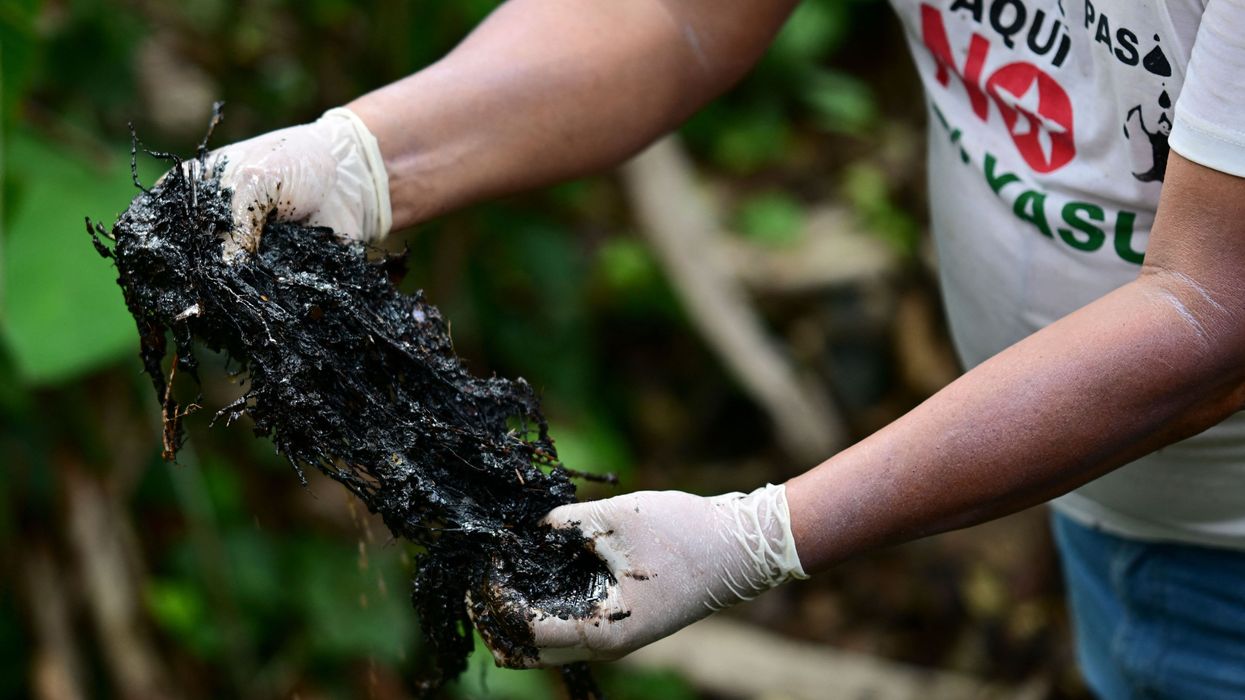December, 02 2010, 03:18pm EDT

For Immediate Release
Contact:
Kate Fried, Food & Water Watch: (202) 683-2500; kfried(at)fwwatch(dot)org
Food & Water Watch's New Factory Farm Map Shows Huge Increase in Factory Farms in Iowa
Iowa’s elimination of counties’ local control a major factor in factory farm expansion
WASHINGTON
The total number of livestock raised in Iowa has increased by more than 51 percent in recent years, finds new analysis released today by the national consumer advocacy organization Food & Water Watch. The organization's updated Factory Farm Map (www.factoryfarmmap.org), which charts the concentration of factory farms across the country and their subsequent affect on human health, communities and the environment, reveals that livestock units in the state increased from 2.2 million units in 2002 to 3.3 million units in 2007. These numbers place Iowa second only to Texas in the number of factory farm livestock.
Food & Water Watch analyzed U.S. Department of Agriculture Census data from 1997, 2002 and 2007 for beef and dairy cattle, hogs, broiler meat chickens and egg-laying operations, and found that Iowa leads all other states in factory-farmed pork and egg production. The number of hogs on factory farms in Iowa grew by 75 percent between 1997 and 2007, from 10.2 million to 17.9 million. Similarly, the number of egg laying chickens on factory farms increased in that time to 52 million, up 174 percent from 19 million in 1997. The average size of egg farms in the state almost tripled in that time to nearly 1.3 million hens per operation in 2007.
"This updated Factory Farm Map shows the proliferation and concentration of factory farms in Iowa since 1997," said Matt Ohloff, Iowa-based Organizer for Food & Water Watch. "Coincidentally, in 1995 the state of Iowa revoked counties' local control over the siting of factory farms, taking away their ability to slow the onslaught of corporate-backed factory farms from moving into the state."
Throughout the U.S., small and medium-scale livestock farms have given way to factory farms that confine thousands of cows, hogs and chickens in tightly packed facilities. While the number of livestock farms in the U.S. has decreased, the total number of livestock on the largest factory farms rose by more than 20 percent between 2002 and 2007. In that period, the average size of the typical factory farm increased by 9 percent.
The Factory Farm Map indicates that certain regions and states bear the brunt of intensive animal production. This is especially true in Iowa, where the 17.9 million hogs, 1.2 million beef cattle, 52.4 million egg-laying hens, 1 million broiler chickens and 64,500 dairy cows raised on factory farms produce as much untreated manure as the sewage of 471 million people. Manure spills from factory farm operations in Carroll County and Clayton County in recent years have contaminated local drinking and surface water supplies.
The map also shows a high concentration of factory farms across the state. According to the map, the counties most densely populated with factory-farmed animals were Sioux County (330, 567 units), Lyon County (128,047 units) and Plymouth County (120,707 units).
"Food and Water Watch's new report and updated factory farms map confirms what Iowa Citizens for Community Improvement members have been saying for years about the dangers factory farms pose to our air, water, and rural quality of life," said Vern Tigges, an independent family farmer and CCI Board President from Carroll, Iowa. "The corporate factory farm industry is environmentally unsustainable and a major contributor to our deteriorating water quality. Iowa Governor-elect Terry Branstad should crack down on factory farm polluters and use his bully pulpit to push for local control, tougher permitting standards, and strong Clean Water Act rules."
Food & Water Watch also released a companion report, Factory Farm Nation, which explains the forces driving factory farms throughout the U.S., as well as the environmental, public health, and economic consequences of this type of animal production. The report also examines the causes for industrial-scale livestock and the demise of small and medium farms.
The Factory Farm Map and the companion report can be found at www.factoryfarmmap.org.
Food & Water Watch mobilizes regular people to build political power to move bold and uncompromised solutions to the most pressing food, water, and climate problems of our time. We work to protect people's health, communities, and democracy from the growing destructive power of the most powerful economic interests.
(202) 683-2500LATEST NEWS
Richest 0.001% Now Own Three Times More Wealth Than Poorest Half of Humanity Combined
"The choices we make in the coming years will determine whether the global economy continues down a path of extreme concentration or moves toward shared prosperity."
Dec 10, 2025
A landmark report on global inequality published Wednesday shows that the chasm between the richest slice of humanity and everyone else continued to expand this year, leaving the top 0.001%—fewer than 60,000 multimillionaires—with three times more wealth than the poorest half of the world's population combined.
The global wealth gap has become so staggering, and its impact on economies and democratic institutions so corrosive, that policymakers should treat it as an emergency, argues the third edition of the World Inequality Report, a comprehensive analysis that draws on the work of hundreds of scholars worldwide. Ricardo Gómez-Carrera, a researcher at the World Inequality Lab, is the report's lead author.
"Inequality has long been a defining feature of the global economy, but by 2025, it has reached levels that demand urgent attention," reads the new report. "The benefits of globalization and economic growth have flowed disproportionately to a small minority, while much of the world’s population still face difficulties in achieving stable livelihoods. These divides are not inevitable. They are the outcome of political and institutional choices."
The richest 10% of the global population, according to the latest data, own three-quarters of the world's wealth and capture more income than the rest of humanity. Within most countries, it is rare for the bottom 50% to control more than 5% of national wealth.
"This concentration is not only persistent, but it is also accelerating," the report observes. "Since the 1990s, the wealth of billionaires and centimillionaires has grown at approximately 8% annually, nearly twice the rate of growth experienced by the bottom half of the population. The poorest have made modest gains, but these are overshadowed by the extraordinary accumulation at the very top."
"The result," the report adds, "is a world in which a tiny minority commands unprecedented financial power, while billions remain excluded from even basic economic stability."
The report comes as the world's richest and most powerful nation, led by President Donald Trump, abandons international cooperation on climate and taxation and works to supercharge inequality by slashing domestic and foreign aid programs while delivering massive handouts to the wealthiest Americans.
Jayati Ghosh, a member of the G20 Extraordinary Committee of Independent Experts on Global Inequality and co-author of the forward to the new report, said in a statement that "we live in a system where resources extracted from labor and nature in low-income countries continue to sustain the prosperity and the unsustainable lifestyle of people in high-income economies and rich elites across countries."
"These patterns are not accidents of markets," said Ghosh. "They reflect the legacy of history and the functioning of institutions, regulations and policies—all of which are related to unequal power relations that have yet to be rebalanced.”
Reversing the decadeslong trend of exploding inequality will require the political will to pursue obvious solutions, including fair taxation of the mega-rich and bold investments in social programs and climate action, which is disproportionately fueled by the wealthy.
"The choices we make in the coming years," the report says, "will determine whether the global economy continues down a path of extreme concentration or moves toward shared prosperity."
Keep ReadingShow Less
'Defeat for Justice': Ecuador to Pay Amazon-Polluting Chevron $220 Million
"A debt is not owed to Chevron. A debt is owed to the Amazonian families still waiting for truth, justice, and full reparation."
Dec 09, 2025
A US advocacy group, American human rights lawyer Steven Donziger, and the group in Ecuador behind a historic legal battle against Chevron over its dumping of toxic waste in the Amazon rainforest are condemning the Ecuadorian government's plans to pay the oil giant hundreds of millions of dollars due to an arbitration ruling.
In response to the legal fight in Ecuador that led to a $9.5 billion judgment against Chevron—which bought Texaco—the fossil fuel company turned to the investor-state dispute settlement (ISDS) system, suing the South American country in the Hague-based Permanent Court of Arbitration. As part of the latter case, Ecuadorian Attorney General Diana Salazar Méndez's office announced Monday that the government would pay the US company only around $220 million, rather than the over $3 billion Chevron sought.
While Chevron said in a statement that it was "pleased with the resolution of this matter" and claimed the decision "strengthened the rule of law globally," and Salazar Méndez's office celebrated the dramatically lower figure, and the Union of Peoples Affected by Chevron-Texaco (UDAPT)—the group that began the case against oil company in 1993—pushed back against the government's framing of the reduction "as if it was a success and an economic achievement."
"The reality is it is a defeat for justice," UDAPT argued in a Tuesday statement. "For 32 years, UDAPT has documented pollution, environmental crime, and lives broken by Chevron, proving what should be obvious: Communities have not recovered, health has not been restored, clean water has not returned, and the territories that sustain life remain contaminated. A debt is not owed to Chevron. A debt is owed to the Amazonian families still waiting for truth, justice, and full reparation."
Amazon Watch deputy director Paul Paz y Miño similarly said Tuesday that "this illegitimate arbitration process is nothing more than Chevron abusing the law to escape accountability for one of the worst oil disasters in history."
"Ecuador's courts ruled correctly and based largely on Chevron's own evidence, that Chevron deliberately poisoned Indigenous and rural communities, leaving behind a mass cancer zone in the Amazon," the campaigner continued. "Adding insult to injury, the idea that Ecuador's people should now pay a US oil company that admitted to deliberate pollution is the epitome of environmental racism."
Ecuadorian President Daniel Noboa "must not honor this ISDS award, and the international community must stand behind the victims of Chevron's crimes and demand that the company clean up Ecuador once and for all," Paz y Miño added. "Amazon Watch stands with the affected Indigenous peoples and communities of the Ecuadorian Amazon. We urge President Noboa to reject this illegitimate award, disclose any negotiations with Chevron, and enforce Ecuadorian law by ensuring Chevron pays its debt to those it poisoned."
Donziger—who was detained in the United States for nearly 1,000 days after Chevron went after him in the American legal system for representing Big Oil's victims in Ecuador—was also sharply critical, saying Tuesday that "the decision by a so-called private corporate arbitration panel that claims to absolve Chevron of its massive pollution liability in Ecuador has no legitimacy and does not affect the historic $9.5 billion damages judgment won by Amazonian communities."
"That judgment still stands as the definitive public court ruling in the case," he said. "The private arbitral panel has no authority over the six public appellate courts, including the Supreme Courts of Ecuador and Canada, that issued unanimous decisions against Chevron and confirmed the extensive evidence that the company devastated local communities by deliberately dumping billions of gallons of cancer-causing oil waste into rivers and streams used by thousands of people for drinking, bathing, and fishing."
"I also strongly condemn President Daniel Noboa for his plans to betray his own people by agreeing to send $220 million from the public treasury to Chevron, a company that owes Ecuador billions under multiple court orders for poisoning vulnerable Indigenous peoples with toxic oil waste," Donziger added. "Noboa would effectively grant Chevron a taxpayer-funded bailout financed by the same citizens who remain victims of the company's pollution. This would be an outrageous dereliction of duty and a violation of his oath of office, warranting removal."
Keep ReadingShow Less
After Judge Tosses GOP Lawsuit, Missouri Voters Submit Signatures for Referendum on Rigged Map
"The citizens of Missouri have spoken loudly and clearly: They deserve fair maps, not partisan manipulation,” said one campaigner.
Dec 09, 2025
Opponents of Missouri's GOP-rigged congressional map on Tuesday submitted more than twice the required number of signatures supporting a referendum on the redistricting scheme backed by US President Donald Trump, a move that followed a federal judge's refusal to block the initiative.
The political action committee People Not Politicians turned in more than 300,000 signatures in support of the referendum to Republican Missouri Secretary of State Denny Hoskins' office in what the group called an "unprecedented show of grassroots power."
The submission—which filled 691 boxes—will be reviewed by state election officials tasked with certifying the validity of the roughly 110,000 signatures required for qualification on the November 2026 ballot. If the signatures are approved, the state would be temporarily prohibited from adopting the new map until after the referendum vote.
Hoskins initially rejected People Not Politicians' referendum petition because Missouri Gov. Mike Kehoe, a Republican, had not yet signed the redrawn map into law. Hoskins said he would reject any signatures collected before Kehoe approved the map in September. At that time, People Not Politicians had collected around 92,000 signatures.
“The citizens of Missouri have spoken loudly and clearly: They deserve fair maps, not partisan manipulation,” People Not Politicians executive director Richard von Glahn said in a statement. “We are submitting a record number of signatures to shut down any doubt that Missouri voters want a say.”
The submission followed a Monday ruling by US District Judge Zachary Bluestone—a Trump appointee—rejecting Republican Missouri Attorney General Catherine Hanaway's bid to block the referendum on grounds that the court had no jurisdiction over a lawsuit filed by Hoskins and the GOP-controlled state Legislature arguing that state referendums on congressional maps are unconstitutional.
Supporters of Missouri's referendum are seeking to block redistricting legislation passed in September as part of Trump's push for Republican-controlled state legislatures to rig congressional maps in a bid to preserve GOP control of Congress by eliminating Democratic-leaning districts.
Texas was the first state to do Trump’s bidding by approving a new congressional map that could help Republicans gain five additional House seats. Last week, the US Supreme Court's right-wing majority gave Texas Republicans a green light to use the rigged map in next year's election.
Democratic California Gov. Gavin Newsom responded to Texas' move by spearheading a successful ballot initiative to redraw the Golden State's congressional map in favor his party. Under pressure from Trump, Republican lawmakers in Indiana, Missouri, and North Carolina launched their own gerrymandering efforts.
In Missouri, Republicans are aiming to win seven of the state's eight congressional seats, including by flipping the 5th District, which is currently held by Democratic Rep. Emanuel Cleaver.
Responding to Tuesday's signature submission, Missouri state Rep. Ray Reed (D-83) said on social media that "today, the people of Missouri did something powerful. Organizers across our state: young folks, retirees, faith leaders, neighbors talking to neighbors, came together to defend the idea that in a democracy, voters should choose their leaders, not the other way around."
"Missouri just showed the country what fighting back looks like and I’m proud to stand with the people who made it happen," Reed added.
Keep ReadingShow Less
Most Popular


